Contrary to popular opinion, quadruple
plate silver isn’t the lesser cousin of traditional silverplate. In
fact, its plating process uses four times the silver as the regular
silver plating. But many pieces of quadruple plate silver now look dull
and black, leading to one of the mysteries of antique collecting—the
extreme tarnishing of what were supposed to be high quality silver plate
pieces.

The gleam of polished silver has always been a real joy to the owner be
he or she rich or poor. But the cost for all but the very rich was
prohibitive. The invention of the process of electroplating changed all
that.
The Invention of Electroplating
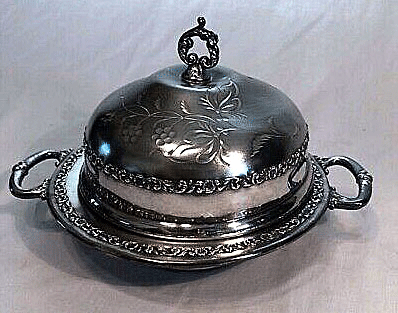 The
first step towards making silver more affordable came around 1839 with
the development of electroplating. Electroplating was possible as a
result of increased knowledge of electrical theory and the galvanic
batteries needed in the process. Workers suspended the object to be
plated in a conductive solution along with an electrode of pure silver.
Passage of electric current through the solution caused pure silver to
be deposited on the object to be plated. Direct current generators
eventually replaced the original batteries as a source of electricity,
enabling manufacturers to use plating tanks large enough for mass
production.
The
first step towards making silver more affordable came around 1839 with
the development of electroplating. Electroplating was possible as a
result of increased knowledge of electrical theory and the galvanic
batteries needed in the process. Workers suspended the object to be
plated in a conductive solution along with an electrode of pure silver.
Passage of electric current through the solution caused pure silver to
be deposited on the object to be plated. Direct current generators
eventually replaced the original batteries as a source of electricity,
enabling manufacturers to use plating tanks large enough for mass
production.
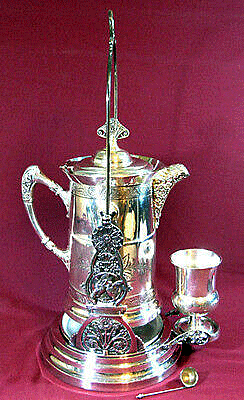 By
the 1850's. a number metal craftsmen had shifted their operations to the
manufacturing of silver-plated wares in various forms ranging from
silver tea and coffee services to silver butter dishes, pickle castors,
cake dishes, silver platters, silver tureens, and table ware. Among the
large manufacturers besides Rogers Brothers was ware Reed & Barton of
Taunton, Massachusetts, which began electroplating in 1848, and Meriden
Britannia Company, founded in 1852 in Madden, Connecticut, and by 1863
the largest of producer of plated silver in America.
By
the 1850's. a number metal craftsmen had shifted their operations to the
manufacturing of silver-plated wares in various forms ranging from
silver tea and coffee services to silver butter dishes, pickle castors,
cake dishes, silver platters, silver tureens, and table ware. Among the
large manufacturers besides Rogers Brothers was ware Reed & Barton of
Taunton, Massachusetts, which began electroplating in 1848, and Meriden
Britannia Company, founded in 1852 in Madden, Connecticut, and by 1863
the largest of producer of plated silver in America.
Since the change from crafting wares of pewter to electroplated silver
occurred at the height of the Victorian period, the pieces made in using
the new method were always more elaborate in design than the earlier
pewter. Not only were the silver-plated pieces ornamented with Victorian
details, they were often embellished with florid end decoration.
 Electroplating
was the ideal process to produce durable and attractive articles that
had most of the desirable qualities of pure silver at a fraction of the
cost. The only
Electroplating
was the ideal process to produce durable and attractive articles that
had most of the desirable qualities of pure silver at a fraction of the
cost. The only
alternative process was Sheffield plate, a mechanical process that
bonded pure silver to copper by heat. But electroplating soon took over
the market.
“White metal," or Britannia metal, which had the same characteristics as
pewter, or nickel silver usually formed the base for electroplating.
Unlike pewter, Britannia contained no lead, making it a superior
product. The usual composition of Britannia consisted of 140 parts tin,
3 parts copper, and 10 parts antimony.
The finest, and most expensive, objects used nickel silver as the base
metal for plating. Nickel silver was an alloy composed of 5 percent to
25 percent nickel, 65 percent copper, and 10 percent to 30 percent zinc.
The resultant metal was strong, took the plating perfectly, and even if
the plated surface became worn, the nickel silver underneath was a good
match for the silver plating.
Although plated objects were far less expensive than solid silver, they
were still relatively expensive for the average family. For example a
six-piece, silver plate on nickel silver tea and coffee service,
consisting of large and small teapots, coffeepot, sugar dish and
creamer, cost around $160 in 1867. A comparable set using silver plate
on Britannia metal was around $50 in the same period. The sixth piece
was known as a "slop." It enabled the gracious hostess to quickly
dispose of the dregs in the bottom of the cup before offering her guest
a fresh cup of tea or coffee. The "slop" was an open topped vessel made
to match the design of the other pieces.
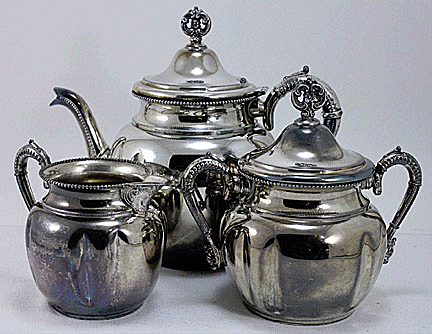
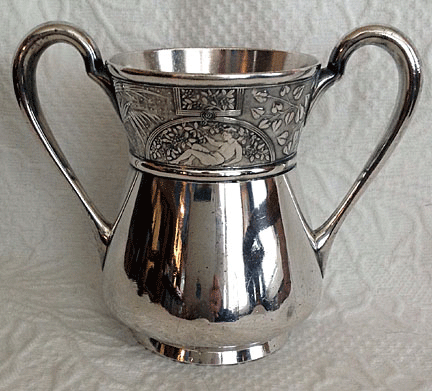 In
addition to the conventional tea and coffee services, 19th-century
manufacturers of silver plate offered many other items, including
pitchers, trays, casters, wine bottles stands, egg holders, cake dishes,
goblets and cups. In addition there was a wide variety of toilet
articles available, including soap dishes, toothbrush holders and
washstand bowl and pitcher sets. The truly elegant home might have a
silver plated parlor spittoon with locking cover. These sold for $4.50
to $6.25 in 1867, depending on how ornate they were.
In
addition to the conventional tea and coffee services, 19th-century
manufacturers of silver plate offered many other items, including
pitchers, trays, casters, wine bottles stands, egg holders, cake dishes,
goblets and cups. In addition there was a wide variety of toilet
articles available, including soap dishes, toothbrush holders and
washstand bowl and pitcher sets. The truly elegant home might have a
silver plated parlor spittoon with locking cover. These sold for $4.50
to $6.25 in 1867, depending on how ornate they were.
At its peak, the silver plating industry during the late 19th century
centered around Meriden, Connecticut. It was here in 1867 that Dennis C.
and Horace C. Wilcox entered the holloware trade, first dealing in
Britannia pieces. Later, around 1867, they established the Wilcox Silver
Plate Company and started making quadruple plated hollowware.
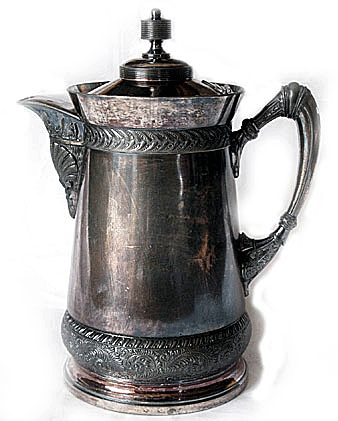 But
what exactly is quadruple plate? Within the silver plate hollowware
industry, items marked as “Standard” indicated that 2 troy ounces of
pure silver had been used to silver electroplate 144 teaspoons. Items
marked "Quadruple Plate," on the other hand, used 8 troy ounces of
silver to plate the same 144 spoons. Thus, quadruple silverplate pieces
were four times as heavily plated with silver than items marked
"Standard" silverplate.
But
what exactly is quadruple plate? Within the silver plate hollowware
industry, items marked as “Standard” indicated that 2 troy ounces of
pure silver had been used to silver electroplate 144 teaspoons. Items
marked "Quadruple Plate," on the other hand, used 8 troy ounces of
silver to plate the same 144 spoons. Thus, quadruple silverplate pieces
were four times as heavily plated with silver than items marked
"Standard" silverplate.
Quadruple silver pieces are not plated four times, but simply had four
times as much pure silver, known in the industry as .925.
So why then are so many quadruple plated silver pieces in such tarnished
condition? While four times the amount of silver used to plate them, the
layers of plating on quadruple plate were much thinner than standard
plating. And while silver is stable in pure air and water, it tarnishes
quickly when exposed to ozone, hydrogen sulfide, or air containing
sulfur. Victorian homes not only had some of these elements present due
to the use of coal-burning stoves and fireplaces, but many upper
middle-class homes had overzealous servants who polished the silver
pieces incessantly. Each time a servant polished a piece of quadruple
plated silver, he or she removed some of the silver.
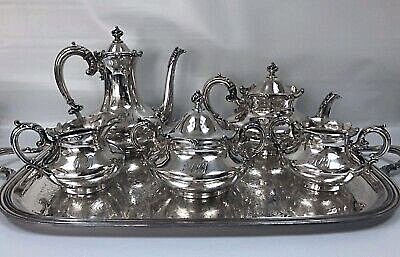
However, pieces plated on nickel silver, such as those produced Rogers
Brothers and Reed & Barton, don’t look as bad today because of their
nickel silver base. And, yes, any piece of quadruple plate can be
replated to look as good as when it was new. But the cost to value ratio
isn’t very good, so replating may cost more than the piece, itself, is
worth.
Identifying Silver-Plated Items
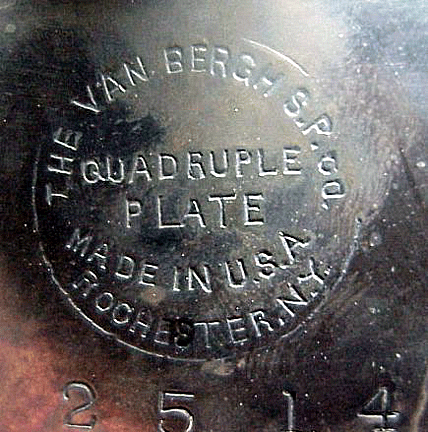 Since
1860, pieces made of solid silver have been stamped as “sterling.” Those
pieces not bearing that stamp were probably plated.. Sterling silver may
also be stamped with “925”, a lion’s head, or another sterling
identification mark. However, there’s no standard system of stamps and
markings for plated silver, so it may be difficult to determine its
origin. Many manufacturers now include a “quadruple plate” mark on their
items.
Since
1860, pieces made of solid silver have been stamped as “sterling.” Those
pieces not bearing that stamp were probably plated.. Sterling silver may
also be stamped with “925”, a lion’s head, or another sterling
identification mark. However, there’s no standard system of stamps and
markings for plated silver, so it may be difficult to determine its
origin. Many manufacturers now include a “quadruple plate” mark on their
items.
Determining the Value of Quadruple Plate
Silver
The value of quadruple silver hollowware or flatware can vary widely
based on a piece’s condition, age, and the collectibility of the maker
or style. Items made before 1880 can be worth considerably more.
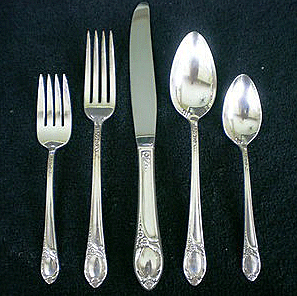 Collectors
can identify the manufacturer and production date in books on antique
silver and flatware. The quadruple plate hollowware pieces that match a
flatware pattern are the most valuable. Quadruple plate silver
hollowware with patterns matching items sold in .925 silver can also be
valuable.
Collectors
can identify the manufacturer and production date in books on antique
silver and flatware. The quadruple plate hollowware pieces that match a
flatware pattern are the most valuable. Quadruple plate silver
hollowware with patterns matching items sold in .925 silver can also be
valuable.
There are about 5,000 different silver-plated flatware patterns; about
300 of these patterns are valuable to collectors who have items with the
same pattern and wish to add to their set. Most quadruple plate silver
items, such as dishes and serving items, sell for under $100. However,
depending on the particular item and its condition, they may be worth up
to several thousand dollars.
Quadruple plate silver in the form of hollowware can be valuable
depending on the item. But unlike sterling silver items, quadruple plate
silver items can't be melted down for their scrap silver value.
Therefore the value of one of these items is determined by its pattern
and collectibility. Some patterns and brands are more valuable than
others and older items can sell for the most money. In particular,
antique items from the 19th century can sell for hundreds of dollars.
< Back to Collecting Archives
Next Article >
